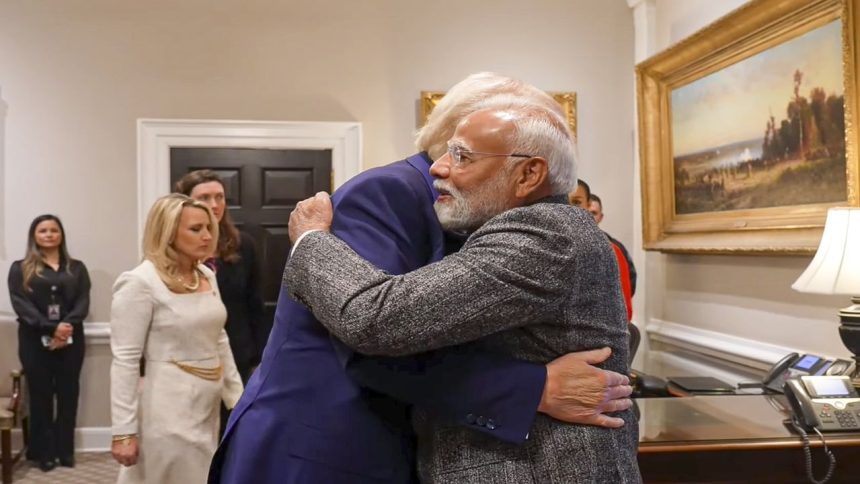The atmosphere inside the Oval Office was tense yet charged with anticipation. It was a high-profile press briefing during Indian Prime Minister Narendra Modi’s visit to the White House, where US President Donald Trump and Modi were set to discuss key geopolitical issues. A room filled with journalists, all eager to extract crucial soundbites, and I was one of them.
I had two pressing questions—one for Prime Minister Modi and another for President Trump.
The Moment of Controversy: My Question to Trump on Bangladesh
I first asked PM Modi about the development related to the Russia-Ukraine peace process initiative launched by Trump and what role India could play in achieving global stability. He responded with his usual diplomatic stance, emphasizing India’s commitment to peace and cooperation.
Then, I turned to President Trump and asked:
“Mr. President, what do you think about the situation in Bangladesh, where it is now evident that the US Deep State was involved in orchestrating a regime change?”
His response was predictable, yet revealing. Trump outright denied any Deep State involvement, which is expected from any sitting or former US president. But then came a moment of political controversy—he mentioned that “I will leave Bangladesh to the prime minister”.
That one sentence sparked a major diplomatic controversy because it implied that the US now considers India as the primary power managing Bangladesh’s affairs—a clear shift in Washington’s South Asia strategy.
Interestingly, just minutes after my question, when the closed-door meeting between Trump and Modi began, the Indian Prime Minister raised the Bangladesh issue himself, expressing India’s deep concerns about the developments there. This was no coincidence—it reflected how Bangladesh’s political situation had become a major geopolitical chess piece between global powers.
Bangladesh’s 2024 Regime Change: A Deep State Operation?
By now, it’s no secret that the August 2024 events in Bangladesh were not just spontaneous student protests—they were part of a well-executed regime change operation.
Student protests erupted in a highly coordinated manner—a pattern seen in previous US-engineered uprisings.
A suspicious shooting incident turned the protests violent, creating a crisis atmosphere.
Western media and diplomatic pressure intensified, calling for “democratic reforms.”
Key political and military figures were swayed into breaking ranks with the government.
As soon as the dust settled, Muhammad Yunus—a longtime Clinton Foundation associate—was placed as Chief Advisor.
At the center of this plot was Donald Lu, a senior US State Department official notorious for executing regime changes in multiple countries. His involvement in Bangladesh followed the same blueprint seen in Ukraine (2014), Georgia (2003), and Kyrgyzstan (2005).
But this was not just about Bangladesh. The US Deep State has been behind regime changes worldwide for decades. Here’s a look at some of its most infamous operations:
The Deep State’s Regime Change Playbook: A Global Pattern
The US intelligence and diplomatic machinery has a well-defined method for overthrowing governments unfavorable to Washington’s strategic interests. It follows a standard pattern:
1.Stage a public uprising – Mobilize protests using economic or political grievances.
2.Orchestrate violence – Use armed provocateurs to escalate clashes.
3.Leverage media warfare – Western media demonizes the sitting government.
4.Pressure the military – Senior military officers are bribed or coerced to abandon the government.
5.Diplomatic isolation – The US and its allies impose sanctions and delegitimize elections.
6.Install a US-backed leader – Once the government collapses, a pro-Western figure takes charge.
Here are some real-world examples where the US Deep State executed regime changes:
1. Serbia – Bulldozer Revolution (2000)
•Target: Slobodan Milošević
•Method: Student-led protests (Otpor!), Western-backed opposition
•Outcome: Milošević overthrown, US-backed government installed.
2. Georgia – Rose Revolution (2003)
•Target: Eduard Shevardnadze
•Method: Youth protests (Kmara), diplomatic pressure
•Outcome: Pro-Western Mikhail Saakashvili took power.
3. Ukraine – Orange Revolution (2004-2005)
•Target: Viktor Yanukovych
•Method: Allegations of election fraud, mass protests
•Outcome: Western-backed Viktor Yushchenko declared president.
4. Kyrgyzstan – Tulip Revolution (2005)
•Target: Askar Akayev
•Method: Protest escalation, foreign-backed opposition
•Outcome: Akayev fled, replaced by a US-aligned leader.
5. Libya – NATO-backed Coup (2011)
•Target: Muammar Gaddafi
•Method: Armed rebels, NATO airstrikes
•Outcome: Gaddafi killed, Libya plunged into chaos.
6. Ukraine – Euromaidan Revolution (2013-2014)
•Target: Viktor Yanukovych
•Method: Sniper attacks on protesters, Western-funded civil movements
•Outcome: Pro-Western government installed.
7. Bangladesh – The 2024 Regime Change
•Target: The ruling government
•Method: Orchestrated student protests, targeted assassinations, military defection
•Outcome: Muhammad Yunus installed as Chief Advisor.
The Bigger Picture: Who Really Benefits?
The pattern is clear: Every US-backed regime change benefits the same set of players—Washington’s foreign policy elite, US defense contractors, Western financial institutions, and global NGOs acting as political enablers.
In Bangladesh’s case, the Deep State’s objectives were clear :
•Secure a pro-US leadership in South Asia.
•Counter China’s growing influence in the region.
•Ensure American economic control over Bangladesh’s industries.
What’s ironic is that while Trump denied the Deep State’s role in Bangladesh’s coup, his own administration was undermined by the same forces during his presidency—something he himself acknowledged on multiple occasions.
Final Thought: Will the World Keep Falling for This?
As a journalist who has reported from war zones and investigated Washington’s covert operations firsthand, I refuse to accept the official narrative at face value.
How long will sovereign nations continue to be pawns in the Deep State’s geopolitical chessboard?
When will leaders resist the scripted “democratic uprisings” that always end with U.-aligned regimes in power?
Bangladesh’s fate is a reminder that no nation is safe from this playbook—unless it wakes up and fights back.




